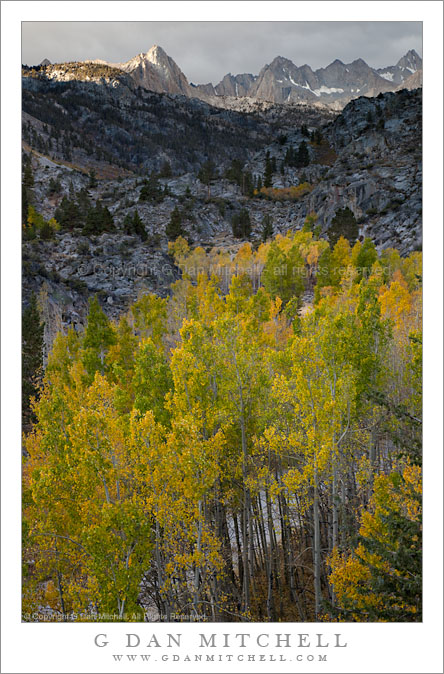(Since posting this message I posted a later update on conditions during this period: “More Eastern Sierra Aspen Color Conditions“.)
I’m currently down in Bishop “doing email” at Starbucks for an hour or so during the harsh light time of the day, so I though I’d post a quick report on conditions in the Bishop Creek area today – along with some (semi-) educated guesses about what lies ahead.
I was up way before dawn this morning and heading up 168 well before the sun came up – there was a bit of light in the sky. My plan was to do “the aspen thing” very early, but as I drove I saw that the clouds were likely to light up in interesting fashion and that it looked like there was some light precipitation on the highest peaks that would soon be illuminated by the sun. So I took a detour out into the Buttermilks on Starlite Road, found a spot looking at Mt. Emerson (?), set up my shot, and waited. I figured that an almost sure thing here was worth a slightly later arrival at the aspens.
The clouds and the wind suggested that the weather forecast of, uh, clouds and wind was probably accurate… I soon finished shooting here and headed up 168. The wind strengthened, at some points blowing hard enough to raise dust clouds on the surrounding slopes. After passing through Aspendell, where the trees are still completely green, I began to see some color just above here. I’d say that it more or less begins above the Cardinal Resort, though the real color starts a bit higher.
I decided more or less spontaneously to try North Lake. I had heard that the “river of color” above the lake had mostly passed its prime and was partially brown, and I knew that the wind would interfere with photographs of the lake, but I also figured that some close-up photographs of sheltered trees might work. There was a fair amount of color along the first part of this road – I came back later and spent some time shooting there as the sun/shadow line approached – and again after the exposed section overlooking Aspendell. Clearly the trees that were further along in the color transitions have taken a bit of a beating from the wind, though there are still quite a few green trees and enough color among the others to make the trip worthwhile. (I also like shooting bare or nearly bare aspen trunks…)
I drove up toward Sabrina but did not stay, instead deciding that the road to South Lake might be more promising. I returned through Aspendell an then turned right to head toward South Lake. The trees before the small village a ways up the road are almost all completely green. Above this village some color starts, and eventually there were some very nice sections. While the conditions ranged from green to yellow to “leaves all gone” and included some brown leaves, there were still plenty of shooting opportunities. I eventually ran out of “good light” as the morning wore on, but I’ll likely had back up that way this afternoon and evening since I located several promising locations.
My general sense of the conditions is that they are a bit unusual. It seems to me that the elevation where the trees start to change color is a bit higher still than I would have expected – it surprised me a bit to see no color at Aspendell, for example. On the other hand, the color started fairly quickly above this level as I ascended. Yes, there are some brown leaves (though these, too, can be interesting photographic subjects) and yes, the wind is blowing down a lot of leaves. But even up high and close to the areas where the leaves have blown down I could find other sheltered groves with excellent color.
So, what now? The weather report still calls for much colder conditions tonight along with the possibility of snow flurries. I think that the aspen conditions in the higher areas are likely to deteriorate somewhat quickly if this holds. On the other hand, there is still a lot of green! The middle and lower elevations have largely not changed yet. Perhaps the change to colder conditions will trigger a change there – and those who are coming up in the next week will find great color.
On another topic: For the past few years Vern Clevenger has had a gallery a couple doors down from the Bishop Starbucks. This morning I saw that Vern is no longer there. I just checked his web site and see that his gallery has moved to Mammoth at 220 Sierra Manor Road #4. I guess that Bishop’s loss is Mammoth’s gain!
Like this:
Like Loading...

